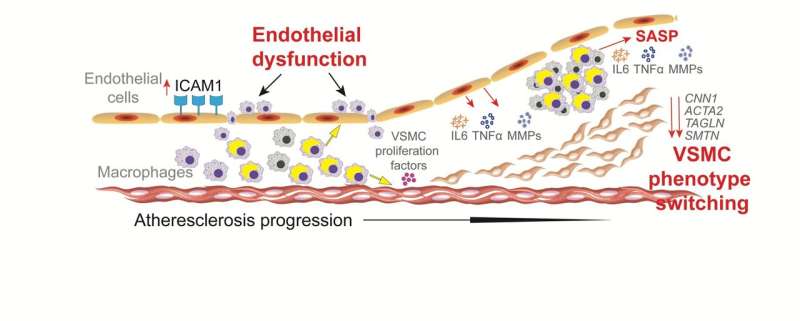This article has been reviewed according to Science X's editorial process and policies. Editors have highlighted the following attributes while ensuring the content's credibility:
fact-checked
peer-reviewed publication
trusted source
proofread
Unraveling the mystery of atherosclerosis in patients with Werner syndrome

Approximately one in every 20,000 to 40,000 children born in Japan and about one in every 100,000 throughout the world bear a mutation in the WRN gene. This gene is responsible for producing the Werner protein, which belongs to the family of human helicases and is responsible for the maintenance of genomic stability, DNA replication, repair of DNA damage, and telomere maintenance.
The mutation in the WRN gene causes a rare genetic disease known as Werner syndrome (WS). Since the affected cells cannot repair DNA damage correctly, patients with WS undergo accelerated aging in early adolescence or young adulthood. Consequently, these patients become more susceptible to age-related diseases, including cataracts, diabetes, and osteoporosis, at a younger age.
However, one of the leading causes of premature death among patients with WS is early-onset atherosclerosis, which involves the buildup of plaque inside and on the arteries. Despite many efforts, the precise mechanisms that predispose patients with WS to atherosclerosis at an early age remain unclear. This gap in understanding is generally attributed to the fact that atherosclerosis involves a variety of chemical signaling exchanged between different types of cells.
Now, however, to address this knowledge gap, a research team led by Associate Professor Naoya Takayama from Chiba University, Japan, has recently developed a novel in vitro co-culture system that can accurately represent atherosclerosis, allowing for in-depth molecular analyses.
Their latest findings on WS using this system were published in Nature Communications on June 10, 2024. The study was co-authored by Sudip Kumar Paul as the first author along with Koutaro Yokote from Chiba University and Koji Eto, affiliated with Chiba University and Center for iPS Cell Research and Application, Kyoto University.
The developed in vitro co-culture system relies on induced pluripotent stem cells (iPSCs), which have recently garnered significant attention in the medical and life science fields. Simply put, iPSCs are essentially adult cells that were reprogrammed to an embryonic-like state.
By stimulating them in specific ways, iPSCs can then transform into almost any desired type of cell and can be cultured accordingly. Since iPSCs can be readily induced from a person's skin or blood cells, their use allows for detailed studies of how a patient's genetic makeup affects the way in which specific tissues behave.
By leveraging iPSCs obtained from WS patients and non-WS (healthy) subjects, the researchers differentiated key cells involved in atherosclerosis—macrophages (a type of immune cell), vascular endothelial cells, and vascular smooth muscle cells (components of the blood vessels).
Subsequently, they not only analyzed the features of these cells individually and their responses to various conditions, but also analyzed the interplay in co-culture of macrophage–vascular endothelial cells and macrophage–vascular smooth muscle cells together.
Using various analytical techniques such as transcriptomics and open chromatin analysis (which reveal the genes involved in a process), the researchers could explain the occurrence of atherosclerosis in patients with WS, by observing the interactions between the vascular and immune cells.
"Our study has revealed that inflammation triggered by mobile genetic elements called retrotransposons and interferon signaling are responsible for atherosclerosis in patients with WS. Macrophages in a pro-inflammatory state are the main malefactors that cause the development of and drive atherosclerosis in these patients, independent of other risk factors," explains Dr. Takayama.
Interestingly, the researchers could partially restore the correct functioning of the cultured WS cells by silencing interferon signaling in macrophages. As per Dr. Takayama, this could become the basis for effective treatment for patients with WS.
He says, "The development of inhibitors targeting the interferon signaling pathway holds promise for reducing the incidence of stroke and heart attacks in patients with WS."
In general, the proposed co-culturing approach could be used to study atherosclerosis efficiently.
"We could successfully observe the interactions between immune cells and vascular cells with a uniform genetic background using our new culture technique. Hopefully, it will facilitate the development of effective drugs against atherosclerosis," concludes Dr. Takayama.
Further studies on atherosclerosis in patients with WS will be needed to substantiate these findings. However, the efforts spearheaded by Dr. Takayama and his team will undoubtedly help develop efficient management strategies and eventually improve the quality of life of patients with WS.
More information: Sudip Kumar Paul et al, Retrotransposons in Werner syndrome-derived macrophages trigger type I interferon-dependent inflammation in an atherosclerosis model, Nature Communications (2024). DOI: 10.1038/s41467-024-48663-w




















